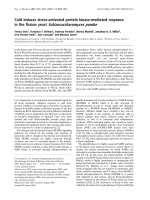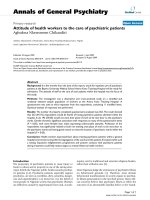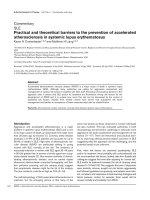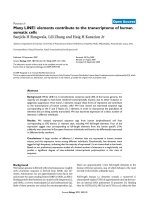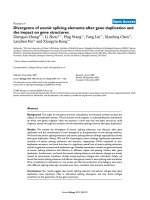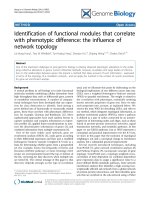Báo cáo y học: "Acute kidney injury: time to shift from creatinine to the estimated glomerular filtration rate" pot
Bạn đang xem bản rút gọn của tài liệu. Xem và tải ngay bản đầy đủ của tài liệu tại đây (37.56 KB, 2 trang )
Page 1 of 2
(page number not for citation purposes)
Available online />Acute kidney injury (AKI) is a complex disorder for which
currently there is no accepted definition. Although several
groups are working on developing and validating biomarkers
of kidney injury and the glomerular filtration rate (GFR), the
proposed diagnostic criteria from the Acute Kidney Injury
Network are based on an absolute increase in serum
creatinine ≥0.3 mg/dl (≥26.4 μmol/l), a percentage increase
in serum creatinine ≥50% (1.5-fold from baseline), or a
reduction in urine output (documented oliguria <0.5 ml/kg
per hour for more than 6 hours) [1].
A recent report from the Laboratory Working Group of the
National Kidney Disease Education Program, however,
recommends that serum creatinine alone should not be used
to assess the GFR or to detect the presence of kidney
disease because it is affected by the GFR and by factors
independent of the GFR, including age, sex, race, body size,
diet, certain drugs, and laboratory analytical methods [2].
Rather, the Working Group suggests implementing the
estimated GFR using the Modification of Diet in Renal Disease
(MDRD) study [2]. In analogy with chronic kidney disease,
implementation of the MDRD equation would probably grant
more clinically useful information to assess AKI.
Letter
Acute kidney injury: time to shift from creatinine to the estimated
glomerular filtration rate?
Giuseppe Lippi and Gian Cesare Guidi
Sezione di Chimica Clinica, Dipartimento di Scienze Morfologico-Biomediche, Università degli Studi di Verona, Ospedale Policlinico G.B. Rossi,
Piazzale Scuro 10, 37134 Verona, Italy
Corresponding author: Prof Giuseppe Lippi,
Published: 25 July 2008 Critical Care 2008, 12:423 (doi:10.1186/cc6936)
This article is online at />© 2008 BioMed Central Ltd
See related research by Mehta et al., />AKI = acute kidney injury; GFR = glomerular filtration rate; MDRD = Modification of Diet in Renal Disease.
Authors’ response
Ravindra L Mehta, John A Kellum, Sudhir V Shah, Bruce A Molitoris, Claudio Ronco, David G Warnock,
Adeera Levin and Michael Joannidis
Lippi and Guidi suggest using the MDRD estimated GFR as
a criterion for diagnosing and staging AKI [1]. The MDRD
estimated GFR was derived from patients with chronic kidney
disease who were at steady state (age <70 years; average
GFR, 40 ml/min/1.73 m
2
) and had renal functional changes
over several months and years [2].
In contrast to chronic kidney disease, patients with AKI have
rapidly changing levels of serum creatinine over a period of
days. Consequently, estimated GFR measurements do not
represent the nonsteady-state conditions inherent in AKI and
are not recommended in hospitalized patients [3]. Secondly,
the estimated GFR is derived from serum creatinine, and
changes in the opposite direction – that is, when serum
creatinine doubles, the estimated GFR is reduced by half.
Using a relative change in serum creatinine is therefore
easier, without the need for an additional step to compute the
estimated GFR. Creatinine and urine output are markers of
severity in AKI, and have been validated as important risk
predictors for outcome [4,5], but do not directly correspond
to kidney function at any given time point.
We concur with Lippi and Guidi that more sensitive, accurate
and predictive indicators of the measured GFR, injury and
prognosis are needed in AKI. Until such markers are validated
and widely available, however, the use of the MDRD estimated
GFR for the diagnosis and staging of AKI does not provide any
additional information to measured changes in serum creatinine.
Page 2 of 2
(page number not for citation purposes)
Critical Care Vol 12 No 4 Lippi and Guidi
Competing interests
The authors declare that they have no competing interests.
References
1. Mehta RL, Kellum JA, Shah SV, Molitoris BA, Ronco C, Warnock
DG, Levin A, Acute Kidney Injury Network: Acute Kidney Injury
Network: report of an initiative to improve outcomes in acute
kidney injury. Crit Care 2007, 11:R31.
2. Myers GL, Miller WG, Coresh J, Fleming J, Greenberg N, Greene
T, Hostetter T, Levey AS, Panteghini M, Welch M, Eckfeldt JH;
National Kidney Disease Education Program Laboratory Working
Group: Recommendations for improving serum creatinine
measurement: a report from the Laboratory Working Group of
the National Kidney Disease Education Program. Clin Chem
2006, 52:5-18.
3. Poggio ED, Nef PC, Wang X, Greene T, Van Lente F, Dennis VW,
Hall PM: Performance of the Cockcroft–Gault and modifica-
tion of diet in renal disease equations in estimating GFR in ill
hospitalized patients. Am J Kidney Dis 2005, 46:242-252.
4. Barrantes F, Tian J, Vazquez R, Amoateng-Adjepong Y, Manthous
CA: Acute kidney injury criteria predict outcomes of critically
ill patients. Crit Care Med 2008, 36:1397-1403.
5. Ricci Z, Cruz D, Ronco C: The RIFLE criteria and mortality in
acute kidney injury: a systematic review. Kidney Int 2008, 73:
538-546.

